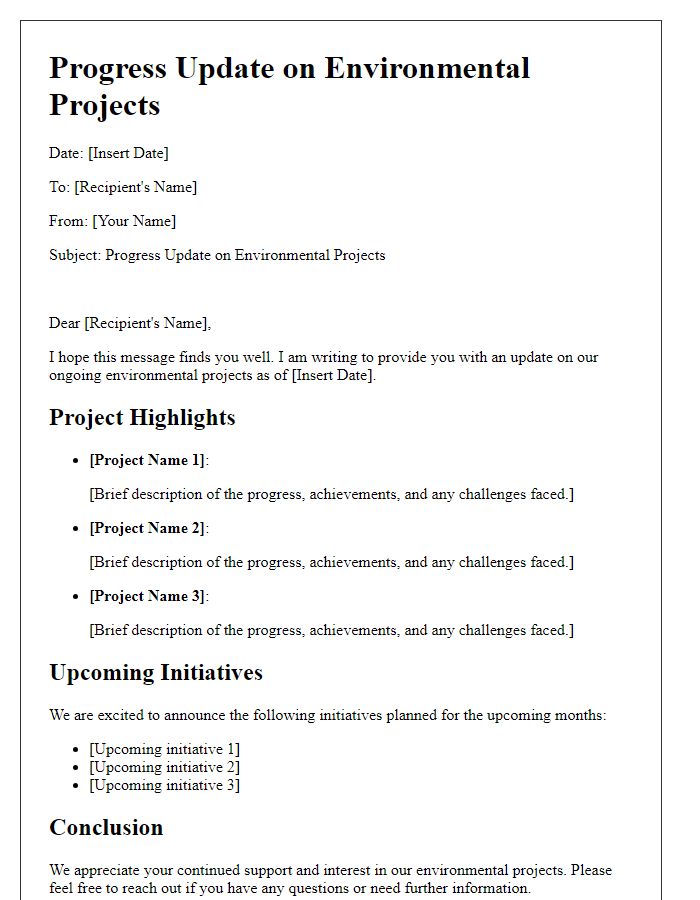Are you passionate about making a difference for our planet? Our eco-friendly initiative aims to inspire individuals and communities to embrace sustainable practices for a greener future. By implementing small changes in our daily lives, we can collectively contribute to the preservation of our environment. Ready to learn how you can get involved and make an impact? Read more to discover the details!

Purpose and Goals of the Initiative
The Eco-Friendly Initiative aims to promote sustainable practices within local communities, targeting waste reduction and resource conservation. Goals include increasing recycling participation rates by 30% over the next year through educational workshops and community events. The initiative seeks to partner with local schools in Springfield, engaging over 500 students in environmental awareness programs. Another objective is to reduce single-use plastic consumption by implementing a "Plastic-Free Day" across 20 participating businesses, encouraging patrons to opt for reusable alternatives. Through these combined efforts, the initiative aspires to foster a culture of environmental stewardship that can significantly contribute to combating climate change and preserving natural habitats.
Key Environmental Benefits
Implementing eco-friendly initiatives, such as solar energy systems in urban locations, offers numerous environmental benefits. Solar panels, capturing sunlight in residential areas, can reduce carbon emissions significantly, potentially lowering a homeowner's carbon footprint by up to 30% annually. Utilizing rainwater harvesting systems can relieve local water systems, conserving thousands of gallons of water each year, particularly in drought-prone regions like California. Urban green spaces, such as community gardens, enhance biodiversity by providing habitats for local wildlife and improving air quality through increased oxygen production. Recycling programs can also contribute to waste reduction, with studies indicating that recycling one ton of paper prevents the release of 1.7 tons of CO2 into the atmosphere and saves 17 trees from being cut down. Adopting these initiatives fosters sustainable practices, ensuring a healthier environment for future generations while promoting community well-being.
Implementation Strategies and Timeline
An eco-friendly initiative focusing on plastic waste reduction can implement strategies like community clean-up events, educational workshops, and partnerships with local recycling facilities. Engagement with over 500 community members can foster awareness about the impacts of single-use plastics. A timeline spanning six months can be established, with month one dedicated to organizing the clean-up event at Riverside Park in May (which has historically gathered more than 300 volunteers), month two to conducting workshops in local schools (targeting over 1,500 students), and months three to six ensuring ongoing support through social media campaigns promoting recycling best practices. Utilizing partnerships with organizations like the Environmental Protection Agency can amplify the initiative's impact and encourage sustainable behavior in the community.
Stakeholder Involvement and Responsibilities
The eco-friendly initiative aims to reduce carbon emissions through community participation and stakeholder involvement. Stakeholders include local governments, non-profit organizations, and businesses focused on sustainability. Local governments, like the City of San Francisco, are tasked with providing regulatory support and funding. Non-profit organizations, such as the Sierra Club, will engage in community education programs to raise awareness about environmental practices. Businesses, particularly those in the retail sector, are responsible for implementing sustainable practices, reducing plastic usage, and promoting eco-friendly products. All stakeholders must collaborate effectively to ensure the success of initiatives such as recycling programs, community gardens, and renewable energy projects, ultimately contributing to a greener future and local ecosystem preservation.
Impact Assessment and Monitoring Plans
An effective impact assessment for eco-friendly initiatives requires a multifaceted approach. Environmental metrics such as carbon footprint, biodiversity indices, and waste management statistics play crucial roles in evaluating the project's success. For instance, a reforestation project in the Amazon Rainforest involves measuring tree growth rates (typically 2 to 3 meters annually for native species) and monitoring wildlife populations through periodic surveys, often conducted biannually. Additionally, community engagement is essential, gauged through feedback sessions and surveys, aimed at understanding local perceptions and benefits derived from the initiative. Progress tracking involves utilizing technology such as satellite imagery or drones to assess changes over time, ensuring transparency and accountability. Regular reporting intervals, such as quarterly updates, help communicate findings to stakeholders and adapt strategies as needed, fostering continuous improvement and sustainable development.
Letter Template For Eco-Friendly Initiative Details Samples
Letter template of corporate social responsibility report on sustainability efforts.
















Comments